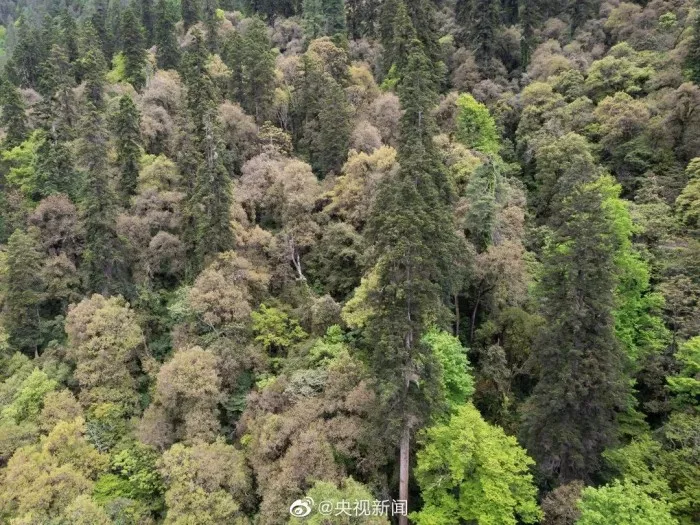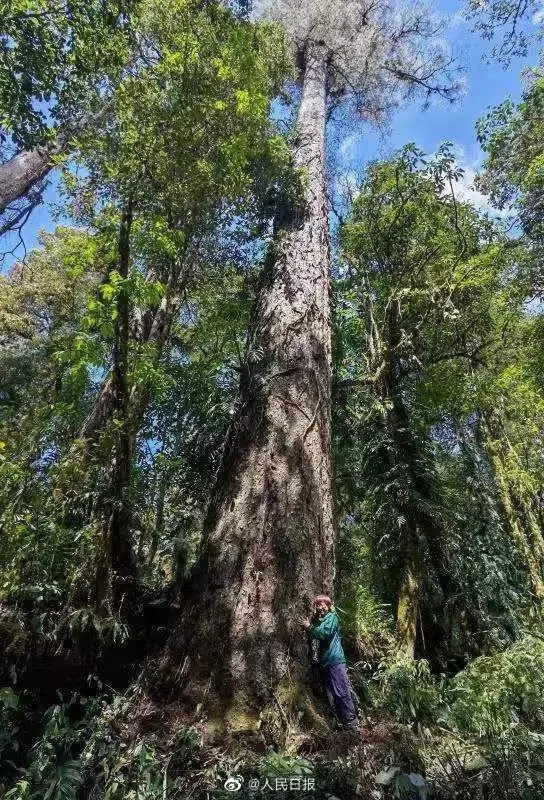"76.8 meters!" "83.2 meters!" Recently, two records on trees have been refreshed! A 76.8-meter-high Bhutanese pine was recorded in Green Village, Beibeng Township, Motuo County, which is the highest known tree in Chinese Mainland. Recently, the scientific research team also found patches of Yunnan HuangGuo fir virgin forest. According to the measurement of UAV sling for many times, the highest one is 83.2 meters high and 207 cm in diameter at breast height, setting a new record for the highest tree in China.


Microblog screenshot
What is Bhutanese pine? What tree is Abies yunnanensis? How do scientists determine its height? What is the significance and value of studying these tall trees? Today, let's walk into the world of big trees.
Bhutanese pine
Unlike most pines that prefer a cool, dry environment, Bhutanese pine is a pine of the pine family that prefers a humid environment. They are only distributed in the Himalayan region. Pinus bungeana is also distributed in Yunnan and Tibet, as well as adjacent Bhutan and India. They often form the coniferous and broad-leaved mixed forest in this area together with the related arbor pine.
Bhutanese pine is a tall tree. In the natural environment, the average height of Bhutanese pine is 25 meters, and the big tree found this time is also a giant in Bhutanese pine group.

Source: @ People's daily
Abies yunnanensis
Abies yunnanensis is a variant of Abies yunnanensis. The main difference from the original species is that the needle leaf is slightly thicker and usually longer. Although it is called fir, Abies yunnanensis is not a real fir. It is a member of Abies in Pinaceae.
Abies yunnanensis grows in areas with an altitude of 2600-3600 meters and a mild climate. The mountains and valleys of brown forest soil are their favorite living environment. Abies yunnanensis usually forms coniferous and broad-leaved mixed forests with coniferous and broad-leaved trees such as Pinus armandii, Taxus chinensis, Fraxinus tomentosa and Populus cathayana. In the forest, the yellow fruit fir with an average height of 60 meters is usually the top tree species, which is superior to other plants.

Source: @ CCTV news
How to measure the height of a big tree
How do scientists get the height of big trees? I believe that the first way to appear in your mind is to measure with a ruler. However, this method is not practical for measuring the height of big trees. Not to mention that climbing a tall tree itself is a difficult problem, but how to ensure that the tape measure is vertical from the top of the tree to the ground is a very difficult task.
Knapsack lidar was used in this determination of the height of budansong. This tool sounds mysterious. In fact, its working principle is very simple. It uses laser to measure the distance between two points. The distance data between the earth and the moon is also measured by laser.
By measuring the position and distance of multiple points in the space, using the computer to process these data, and finally establish the 3D mapping data model of the area where the big tree is located. In this way, it becomes very easy to accurately calculate the height of the big tree.

Source: @ People's daily
During the measurement of Abies yunnanensis, the UAV sling was used for many measurements. The UAV was used to fly to the place flush with the top of the tree crown, put down the sling, and then measure the length of the sling. The use of UAV can ensure the vertical tension of the lifting rope and more accurately reflect the real height of trees.
Why can't plants grow infinitely high
Most plants have a life span, and even many tall trees have a fixed life cycle. The most typical should be the palm palm palm. The height of this tree can exceed 30 meters, but they have a fixed breeding cycle. As soon as 60 years come, the palm will blossom and bear fruit, and the life of this tree will come to an end.
Many plants can blossom and bear fruit many times in their life and breed offspring, just like Bhutanese pine. Theoretically, plant cells in different tissues retain certain omnipotence. Therefore, plants have a strong ability to repair themselves. Even if one branch is cut off, or even the whole crown is cut off, they will still grow new branches and leaves. As long as the root system, stem and the conducting tissue in the leaves are not damaged and the leaves can carry out photosynthesis normally, the big tree will survive all the time. So in this sense, if the conditions are right, these stem cells exist and different tissues can be renewed continuously, the plant will not die.
However, in nature, it is difficult for plants to live forever. As long as the time is long enough, all regions will encounter emergencies. Even if it is not debris flow, hurricane, earthquake, diseases and pests, it will also encounter ice age and long-term drought. Even if you are lucky enough to avoid all natural disasters, you have to face the competition of new species. Therefore, there is no possibility for a big tree to live forever, and no big tree can grow tall indefinitely.
What's the point of studying big trees
The study of these trees is of immeasurable value for us to study the evolution of biological communities and ecological adaptation in a region. Of course, studying giant trees can also help us solve a scientific puzzle, that is, how to transfer water and mineral nutrition from the roots to the branches above?
For example, the Bhutanese pine discovered this time is 76.8m high, which is converted into a residential building, which is roughly equivalent to the height of 25 floors. Without the pressure provided by the water pump, we simply can't enjoy the tap water service at such a height. So how does a big tree without a pump send water from its roots to its branches?
At first, people thought that big trees lifted water through capillary action. The so-called capillary action is that water will "climb" up along very thin pipes. The thinner these pipes are, the higher the climbing height is. However, after calculation, it is found that the capillary effect produced by the size of the large tree transmission pipeline (vascular bundle) can not send water to a place tens of meters high at all.
In fact, the big tree really has a "water pump" - the leaves at the top of the branches. The leaves constantly release water vapor into the air, so that the water in the vascular bundle of the trunk will be supplemented. Through this transmission, the water absorbed by the root will be "pumped" up. Because it is related to transpiration, this special lifting force is called transpiration pull. However, how the water supply system works all year round and why it produces such a huge pull is still a mystery.
The two record breaking trees discovered this time are of great value and significance for us to study the physiology of plants, especially the physiology of water and nutrient transport.
Expert: Shi Jun, botany researcher, member of the scientific communication committee of the Chinese botanical society